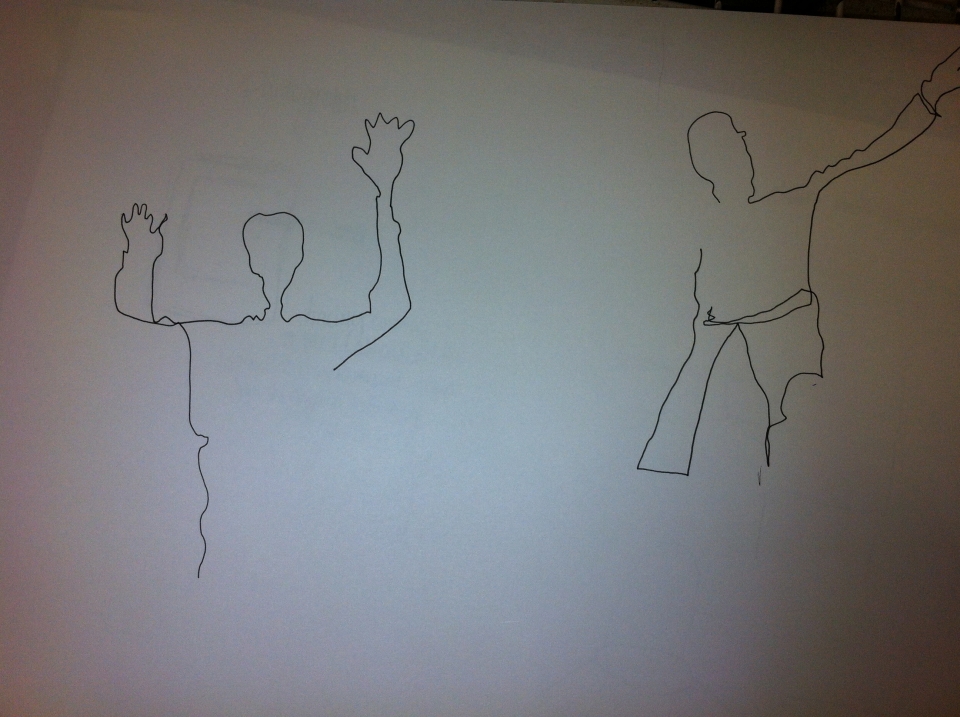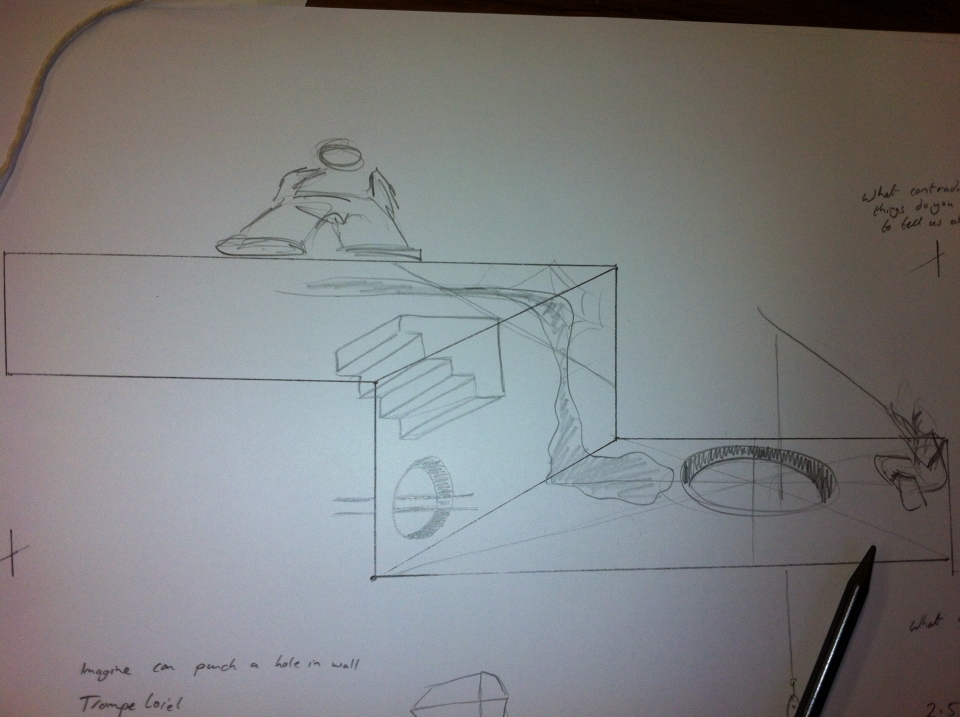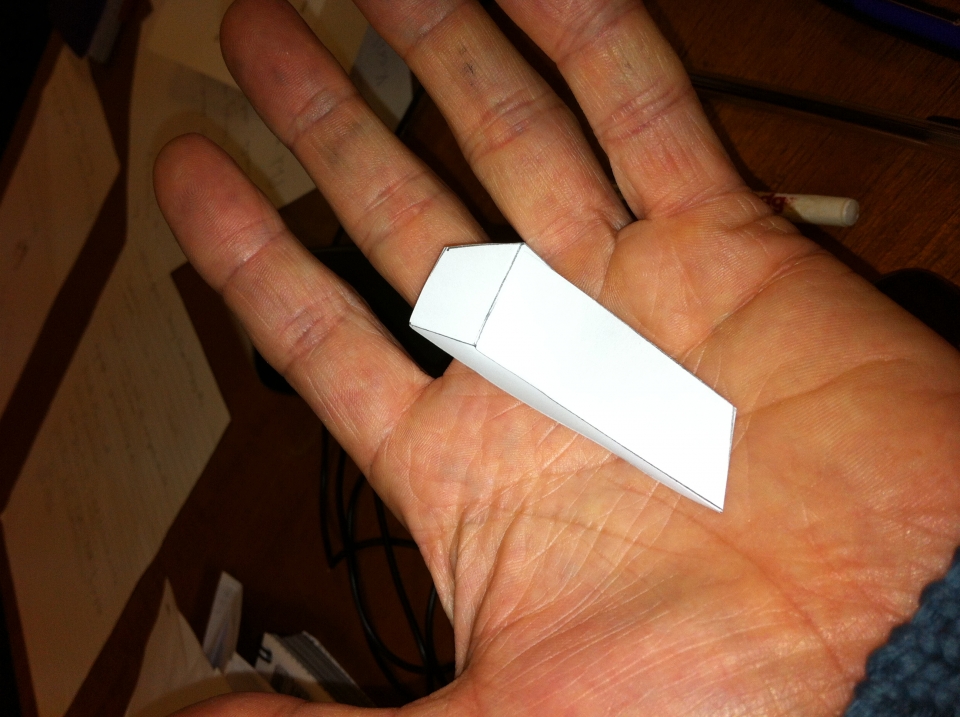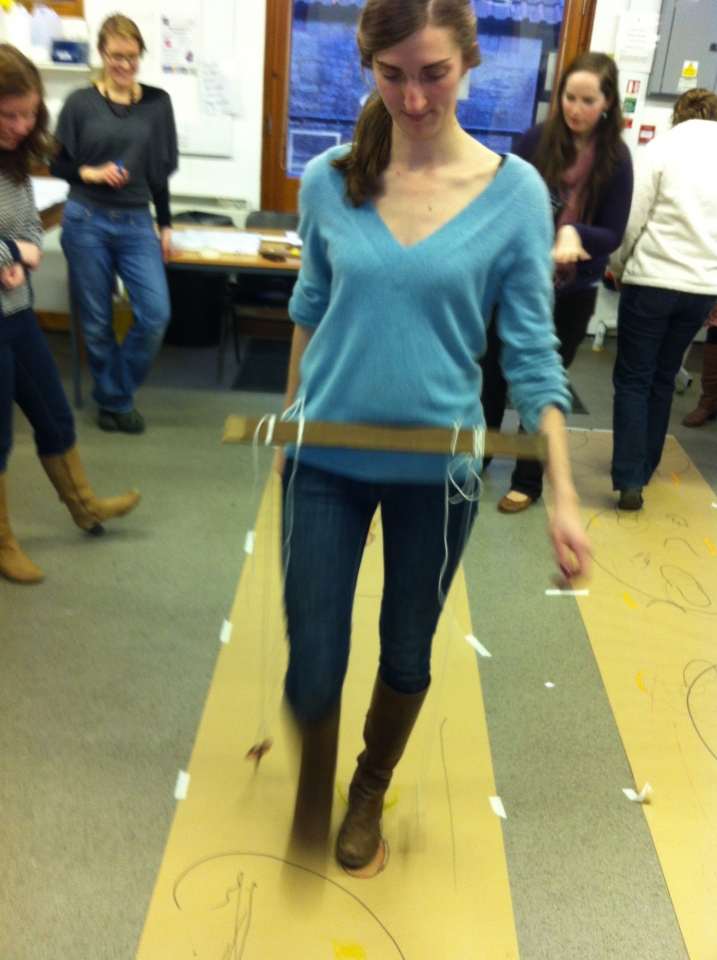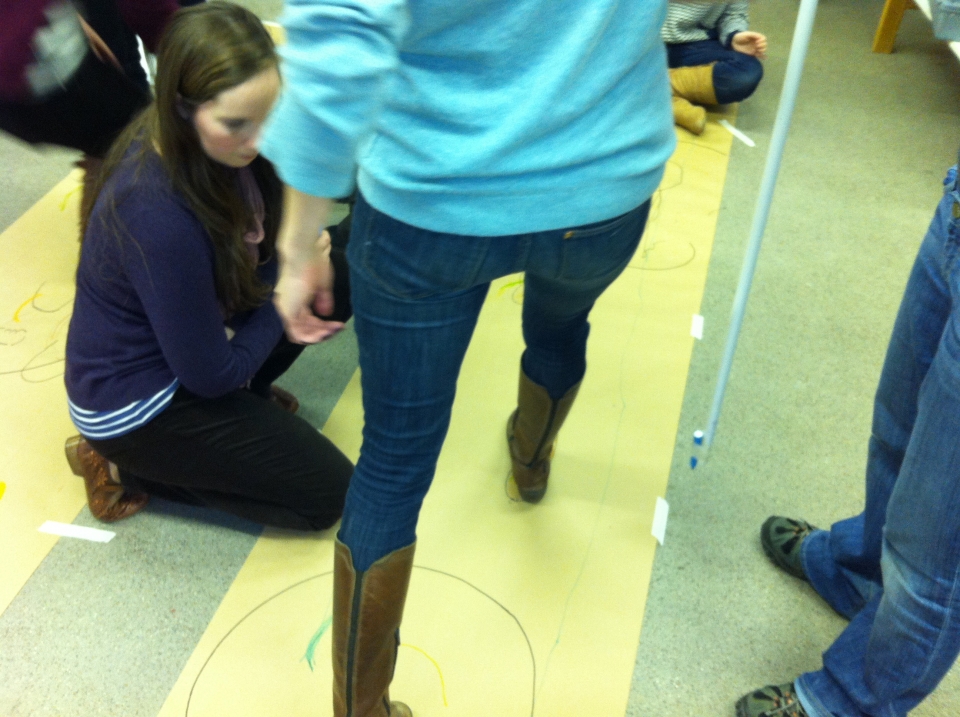Blog
Drawing space and time - using drawing as a tool for philosophy
Added 20th January 2013
Art teachers encountering ways of exploring perspective, figure drawing and understanding space and time. Finding ways in which teachers can make connections for their students between the art lessons and those artists who are seen as philosophers or savants.
2.5 hours of drawing in different ways - discussing the outcomes, the thoughts it provoked and the artists that they see as relevant
1. Concept of single view point perspective in a 3D (not 2D) space – using using meter rulers as vanishing lines in real space. Noticing changing angles of the rulers as position is changed in the room or move from seated to standing to standing on chair to standing on table.
2. Ridicule the approach to teaching perspective that drags the child to a result by placing a vanishing point (VP) in the middle of the page and using it to make a picture of a room with no thought for controlling the viewpoint, why or how this works. Show how using perspective as a taught trick leaves children stranded with a limited use of a valuable tool.
3. Get them to state that the VP for the continuation of lines where the walls meet ceilings relates to the height of the eyes of the viewer. From imagination create two different horizon levels in a similar room by creating a VP at the hieght of a cat and person.
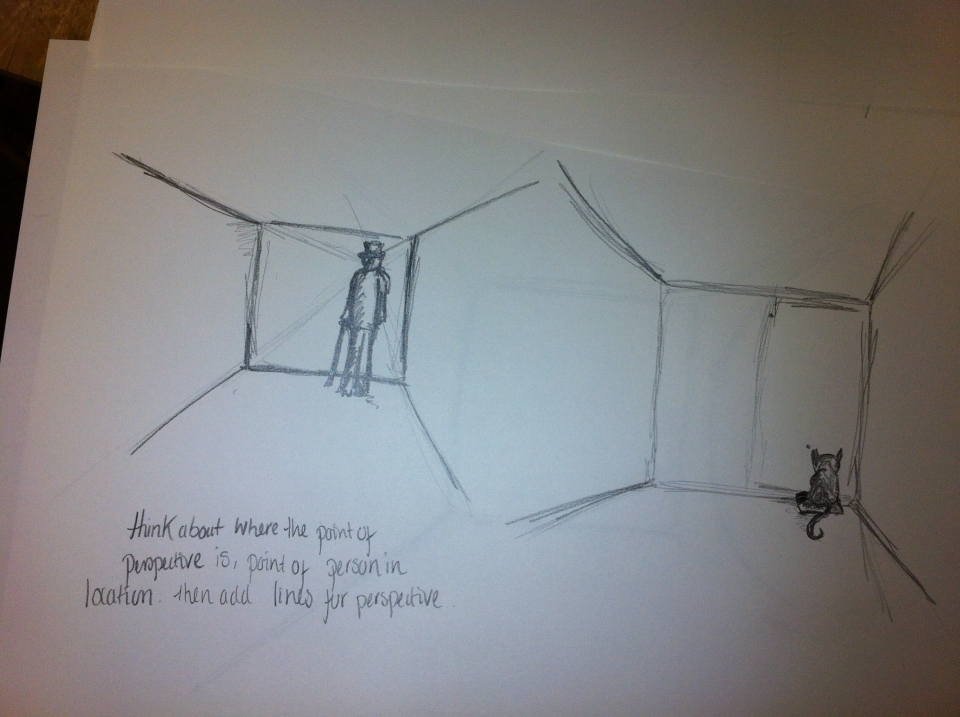
4. Mention Rennaisance navigators and the stars and that the invention of perspective enabled artists to predict curvature of the earth, movement of the planets and the position of the earth in relation to its solar system. These artists could be called mathematicians. How could this knowledge and the positioning of a vanishing point on the page empower a child’s powers of expression?
5. This single viewpoint perspective is not intuitive – mapping what we know is more intuitive and we need to look at that later. Try looking at a chair and mapping – making a diagram with no knowledge of perspective. Explore and compare results and ways of drawing a chair.6. Closing one eye is the key to drawing from a single view point. Drawing was part of an army officers training and up to the Second World War still used in preference to photos. Try regimented use of 3 grades of mark making for fore, middle and background – Demonstrate the clamped head on a tree and the gridded viewfinder – imagine it in the field in the early 1900s -Discuss making the viewfinders for 30 students and finding ways of doing this and what an officers drawing frame would look like
7. Use this clamped head single viewpoint approach and sighting – demonstrate and try it starting with the mechanical use of a pantograph style drawing tool and an easel to trace the world onto the page
8. Run through the use of pin ruler and pen exercise on the easel
9. Remove ruler and pin but draw using the sighting hand eventually draw having removed the sighting hand
10. Now draw without looking at the page –10 sec exercises drawing the teacher/tutor
11. Use this method to draw foreshortened figures – looking up and down on me
12. Put the figures into a space
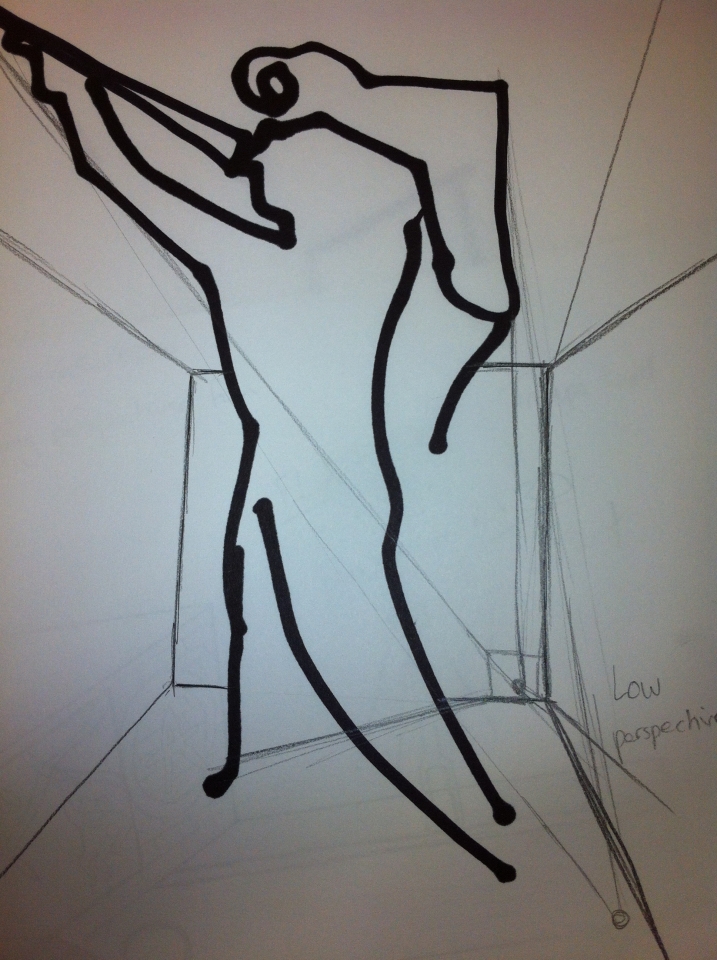
13. How many dimensions are we drawing in when we create an illusion of space. Discuss concept of flat man living in flat-mans world ..whats it like living there being an illusion of space is it like 2.5D ? What would it be like living in our 3D world with the capability of 3.5D? Discuss dimensions
14. Play with figures in their own impossible spaces .. whats it like living there? Whats it like for a child being able to control this illusion
15. Play with this illusion in our 3D world by inverting a simple hand held folded paper form that looks solid but is hollow. Shut one eye to view and what happens when it moves.
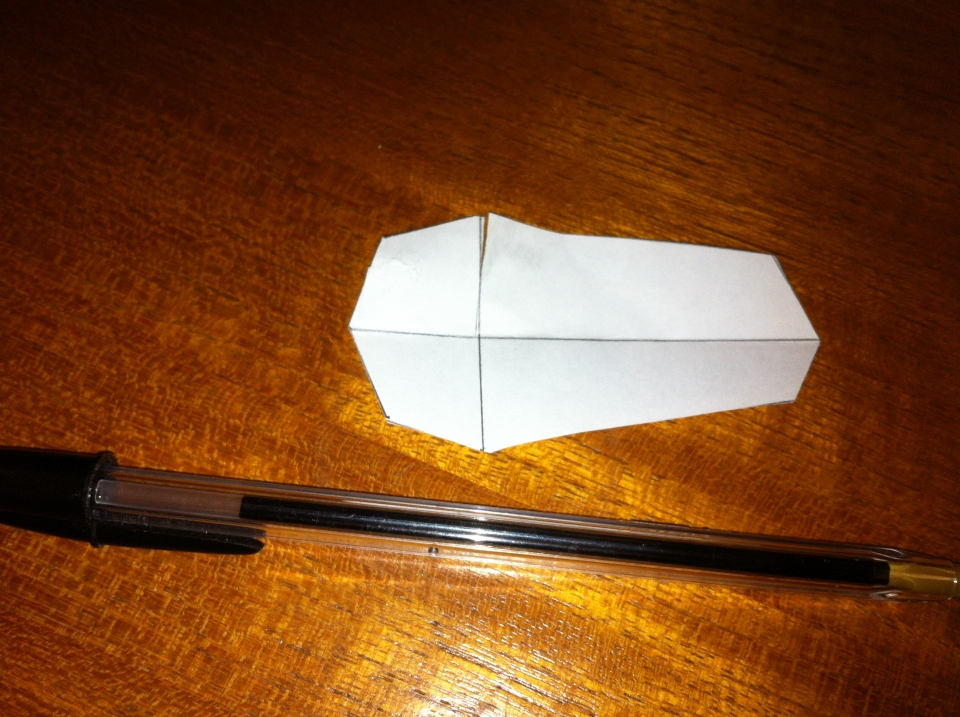
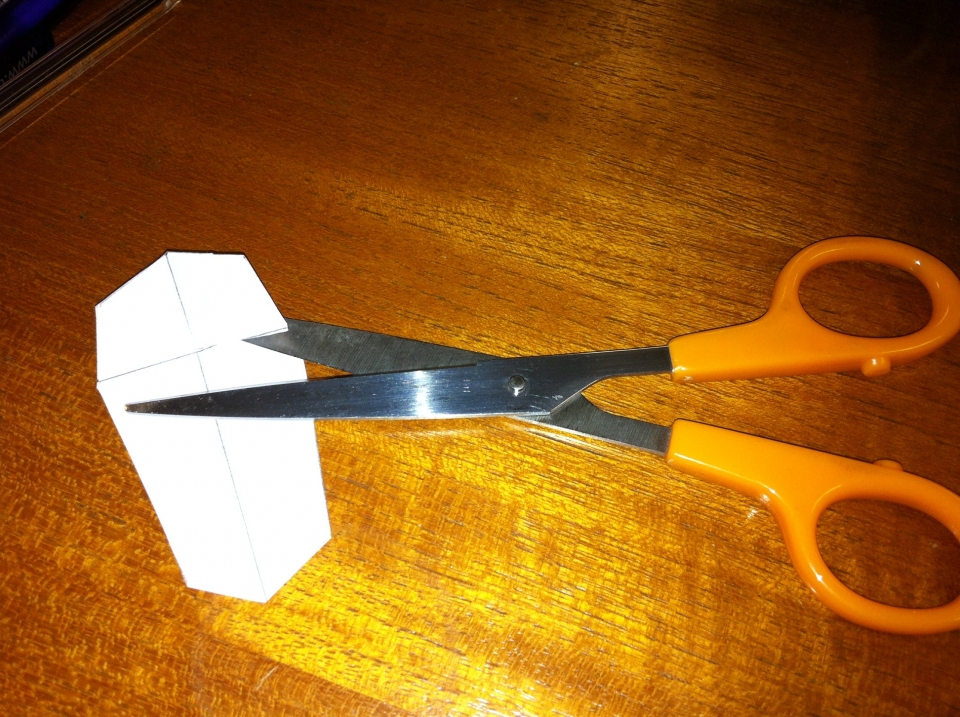
16. Drawing the figure as an illusion has had its day? .. refer to art history .. are there more honest ways of representing a figure in space?
17. Drawing around the hand .. pressing the body onto a surface .. Yves Klein performance piece perhaps the most famous but Leonardo's Man in a circle. How else could we map the body in space can we add another dimension to the tasks by being honest– work in teams on paper on the floor to map a walk. Develop a language that works to explain the event on the paper.
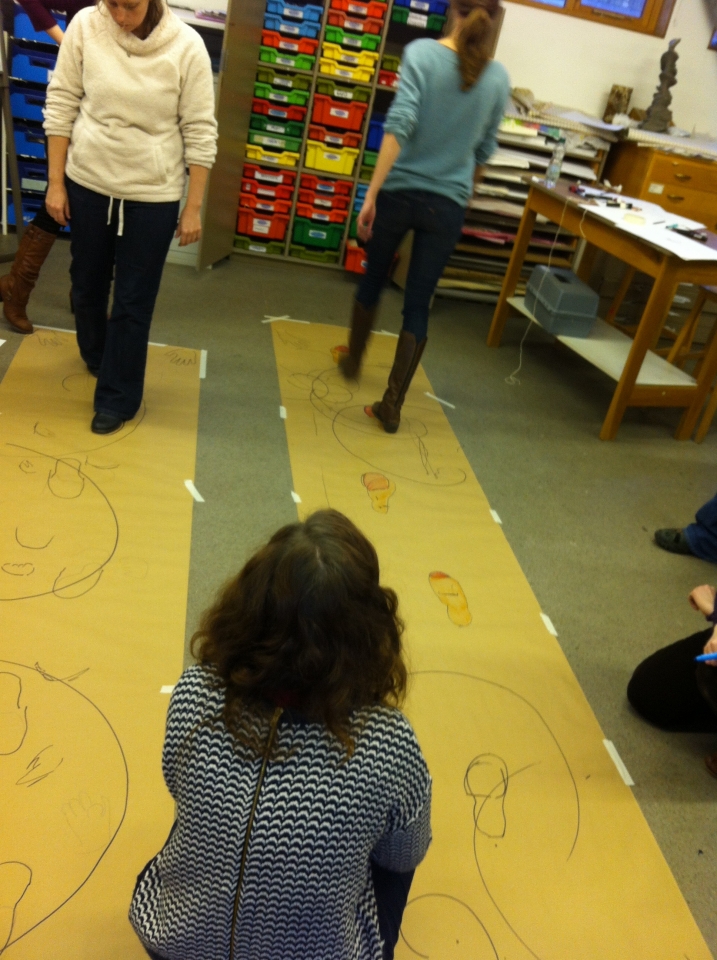
End with the take away 3D illusion to be done before sleep and dreams recorded and give them the mission to make the school art room a space for intellectual and philosophical discussion .... what is a worm hole?
Blog Tags
- 'My Future Clubs' (3)
- Aviation (35)
- Bristol Loves Tides (21)
- Build My Future (20)
- Carboard Boat Race (1)
- Cards (8)
- careers (2)
- catch the train to my future (2)
- Citizenship (21)
- Classroom Afloat (9)
- Coaching (2)
- community (16)
- competition (16)
- Constructing and creating (98)
- consultancy (1)
- CPD (14)
- Crossing Coasts - Windrush Project (3)
- Design My School (1)
- Design solutions (12)
- DIY Energy (4)
- Documentary film making (1)
- Early Years (3)
- Engineering (100)
- Engineers (25)
- Engineers Top Trumps Pack (8)
- Entrepenuer (1)
- Exhbitions on Balmoral (2)
- Family (26)
- female engineers (29)
- Festivals (1)
- Financial Education (1)
- Goal Setting (4)
- Higher Education (9)
- Home Learning (2)
- IMechE (4)
- Ingenious (8)
- Institute of Structural Engineers (1)
- Learning Ships (31)
- Learning Ships (3)
- learning Ships (1)
- Lifting Aspirations - Accessing Engineering (20)
- Literacy (1)
- Museum (15)
- outdoors learning (14)
- parents (5)
- PHSE (17)
- Plan My Future (1)
- Power and thrust (12)
- Primary (24)
- Primary (12)
- Primary School (35)
- Reach Out My Experience (2)
- Resources (11)
- Resources - Card Game, Posters, Workbooks etc (7)
- Rocking the Boat (1)
- Science Festival (5)
- Science learning (18)
- Secondary (26)
- Secondary school (52)
- Self Belief (10)
- self evaluation (7)
- Shipping 2050 (2)
- survey (1)
- Sustainability (1)
- transition (13)
- UTC (2)
- Visioning (26)
- Volunteering (35)
- Windrush (2)
- Work Experience (23)
- Workshops (32)
- Wroughting (1)
- 'My Future Clubs' (3)
- Aviation (35)
- Bristol Loves Tides (21)
- Build My Future (20)
- Carboard Boat Race (1)
- Cards (8)
- careers (2)
- catch the train to my future (2)
- Citizenship (21)
- Classroom Afloat (9)
- Coaching (2)
- community (16)
- competition (16)
- Constructing and creating (98)
- consultancy (1)
- CPD (14)
- Crossing Coasts - Windrush Project (3)
- Design My School (1)
- Design solutions (12)
- DIY Energy (4)
- Documentary film making (1)
- Early Years (3)
- Engineering (100)
- Engineers (25)
- Engineers Top Trumps Pack (8)
- Entrepenuer (1)
- Exhbitions on Balmoral (2)
- Family (26)
- female engineers (29)
- Festivals (1)
- Financial Education (1)
- Goal Setting (4)
- Higher Education (9)
- Home Learning (2)
- IMechE (4)
- Ingenious (8)
- Institute of Structural Engineers (1)
- Learning Ships (31)
- Learning Ships (3)
- learning Ships (1)
- Lifting Aspirations - Accessing Engineering (20)
- Literacy (1)
- Museum (15)
- outdoors learning (14)
- parents (5)
- PHSE (17)
- Plan My Future (1)
- Power and thrust (12)
- Primary (24)
- Primary (12)
- Primary School (35)
- Reach Out My Experience (2)
- Resources (11)
- Resources - Card Game, Posters, Workbooks etc (7)
- Rocking the Boat (1)
- Science Festival (5)
- Science learning (18)
- Secondary (26)
- Secondary school (52)
- Self Belief (10)
- self evaluation (7)
- Shipping 2050 (2)
- survey (1)
- Sustainability (1)
- transition (13)
- UTC (2)
- Visioning (26)
- Volunteering (35)
- Windrush (2)
- Work Experience (23)
- Workshops (32)
- Wroughting (1)
Blog Archives
- September 2025 (2)
- August 2025 (1)
- July 2025 (4)
- April 2025 (3)
- November 2024 (3)
- October 2024 (3)
- September 2024 (3)
- August 2024 (2)
- July 2024 (2)
- May 2024 (2)
- January 2024 (1)
- December 2023 (4)
- October 2023 (2)
- August 2023 (2)
- July 2023 (2)
- June 2023 (1)
- May 2023 (1)
- April 2023 (1)
- March 2023 (2)
- February 2023 (1)
- January 2023 (1)
- November 2022 (1)
- September 2022 (2)
- August 2022 (1)
- July 2022 (4)
- April 2022 (1)
- March 2022 (1)
- December 2021 (1)
- October 2021 (2)
- September 2021 (5)
- July 2021 (2)
- June 2021 (1)
- May 2021 (3)
- April 2021 (1)
- March 2021 (2)
- February 2021 (2)
- December 2020 (2)
- November 2020 (1)
- October 2020 (5)
- August 2020 (1)
- July 2020 (1)
- June 2020 (1)
- May 2020 (2)
- April 2020 (2)
- January 2020 (1)
- December 2019 (2)
- November 2019 (2)
- September 2019 (2)
- August 2019 (2)
- July 2019 (3)
- June 2019 (5)
- May 2019 (4)
- April 2019 (2)
- March 2019 (1)
- December 2018 (1)
- November 2018 (2)
- October 2018 (7)
- September 2018 (2)
- August 2018 (1)
- July 2018 (5)
- June 2018 (2)
- May 2018 (3)
- April 2018 (1)
- March 2018 (5)
- February 2018 (3)
- November 2017 (2)
- October 2017 (1)
- August 2017 (1)
- July 2017 (6)
- May 2017 (2)
- April 2017 (2)
- March 2017 (2)
- February 2017 (1)
- January 2017 (2)
- December 2016 (3)
- November 2016 (6)
- August 2016 (3)
- July 2016 (4)
- June 2016 (1)
- May 2016 (1)
- March 2016 (3)
- February 2016 (1)
- December 2015 (2)
- November 2015 (3)
- October 2015 (1)
- September 2015 (1)
- August 2015 (1)
- July 2015 (5)
- May 2015 (3)
- April 2015 (2)
- March 2015 (3)
- February 2015 (1)
- January 2015 (2)
- December 2014 (2)
- November 2014 (6)
- October 2014 (1)
- September 2014 (3)
- August 2014 (1)
- July 2014 (3)
- June 2014 (1)
- May 2014 (2)
- April 2014 (1)
- March 2014 (3)
- February 2014 (2)
- January 2014 (3)
- December 2013 (6)
- November 2013 (4)
- October 2013 (3)
- September 2013 (1)
- August 2013 (4)
- July 2013 (4)
- June 2013 (2)
- May 2013 (1)
- April 2013 (1)
- March 2013 (2)
- January 2013 (1)
- December 2012 (2)
- October 2012 (3)
- September 2012 (2)
- August 2012 (1)
- July 2012 (6)
- May 2012 (3)
- April 2012 (2)
- March 2012 (1)
- February 2012 (4)
- January 2012 (4)
- November 2011 (2)
- October 2011 (2)
- September 2011 (7)
- August 2011 (2)
- November -0001 (1)
